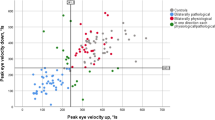Summary
A statistical analysis of pursuit eye movements in 17 patients with unselected circumscribed unilateral hemispheric lesions and in 11 normal subjects was carried out.
Brain-damaged patients showed a significantly more extensive saccadation than controls. Approximately one third of the patients showed a pathological saccadation of follow movements in both horizontal directions. An unequivocally unilateral saccadation on following movements toward the side of the lesions was found in only four cases. Whereas the extent of saccadation was not found to be related with the degree of severity of mental deterioration, it correlated with the simple visual reaction time.
The diagnostic value of pathologic saccadation for the differentiation between organic and non-organic mental deterioration is discussed. The result that the severity of saccadation exceeds clearly the normal degree of saccadation and the fact that the extent of saccadation is not related with mental deterioration is felt to confirm the diagnostic usefulness of the phenomenon.
Zusammenfassung
Bei 17 Patienten mit umschriebenen einseitigen, hinsichtlich der intrahemisphärischen Lokalisation unausgelesenen Hemisphärenschäden sowie bei 11 gesunden Versuchspersonen wurden die Folgebewegungen der Augen untersucht (EOG) und eine quantitative statistische Analyse der Folgeleistung durchgeführt.
Die Patienten zeigten eine signifikant stärkere Sakkadierung als die gesunden Versuchspersonen. Bei etwa zwei Drittel der Patienten trat eine pathologische Sakkadierung in beiden horizontalen Blickrichtungen auf. Nur in 4 Fällen mit parietaler Läsion zeigte sich eine eindeutig einseitige und zur Läsion ipsilaterale Sakkadierung. Ein Zusammenhang zwischen dem Grad der Sakkadierung und der Schwere der psycho-organischen oder intellektuellen Beeinträchtigung konnte nicht bestätigt werden. Dagegen fand sich eine signifikante Korrelation zwischen dem Ausmaß der Sakkadierung und der einfachen visuellen Reaktionszeit.
Es wird die Frage der psycho-diagnostischen Relevanz der pathologischen Sakkadierung für die Abgrenzung zwischen hirnorganisch und nichthirnorganisch bedingten Beeinträchtigungen der intellektuellen Leistungen diskutiert. Das Resultat, daß auch bei Patienten mit umschriebenen einseitigen Läsionen das Ausmaß der Sakkadierung einerseits den bei gesunden Personen festgestellten normalen Grad deutlich überschreitet und andererseits nicht mit der intellektuellen Leistungsbeeinträchtigung korreliert, wird als Bestätigung der psycho-diagnostischen Brauchbarkeit des Merkmals interpretiert.
Similar content being viewed by others
Literatur
Blackburn, H. L., Benton, A. L.: Simple and choice reaction time in cerebral disease. Confin. neurol. (Basel) 15, 327–338 (1955).
Bruhn, P., Parsons, O. A.: Continuous reaction time in brain damage. Cortex 7, 278–291 (1971).
Brune, F., Lücking, C.-H.: Oculomotorik, Bewegungswahrnehmung und Raumkonstanz der Sehdinge. Nervenarzt 40, 413–421 (1969).
Cords, R.: Zur Pathologie der Führungsbewegungen. Albrecht v. Graefes Arch. Ophthal. 123, 174–218 (1930).
De Renzi, E., Faglioni, P.: The comparative efficiency of intelligence and vigilance tests in detecting hemispheric cerebral damage. Cortex 1, 410–433 (1964/65).
Donnelly, E. F., Dent, J. K., Murphy, D. L., Mignone, R. J.: Comparison of temporal lobe epileptics and affective disorders on the Halstead-Reitan Test Battery. J. clin. Psychol. 28, 61–62 (1972).
Gassel, M. M., Williams, D.: Visual function in patients with homonymous hemianopia. Part. II. Oculomotor mechanisms. Brain 86, 1–36 (1963).
Hartje, W., Orgass, B.: Die diagnostische Effizienz von drei psychologischen Verfahren zur Auslese hirngeschädigter Patienten. Arch. Psychiat. Nervenkr. 216, 172–187 (1972).
Hirschmann, J.: Normale und pathologische Führungsbewegungen der Augen. Dtsch. Z. Nervenheilk. 187, 446–454 (1965).
Hoyt, W. F., Daroff, R. B.: Supranuclear disorders of ocular control systems in man. In: The control of eye movements, S. 175–235, P. Bach-y-Rita und C. C. Collins (Hrsg.). New York-London: Academic Press 1971.
Jung, R., Kornhuber, H. H.: Results of electronystagmography in man: The value of optokinetic, vestibular, and spontaneous nystagmus for neurologic diagnosis and research. In: The oculomotor system, S. 428–482, M. B. Bender (Hrsg.). New York-Evanston-London: Harper & Row 1964.
Kerschensteiner, M., Hartje, W., Orgass, B., Poeck, K.: The recognition of simple and complex realistic figures in patients with unilateral brain lesion. Arch. Psychiat. Nervenkr. 216, 188–200 (1972).
Kestenbaum, A.: Blickbewegungen und Blicklähmungen. Confin. neurol. (Basel) 2, 121–147 (1939).
Kestenbaum, A.: Clinical methods of neuro-ophthalmologic examination, 2. Aufl. New York-London: Grune & Stratton 1961.
Kornhuber, H.: Physiologie und Klinik des zentralvestibulären Systems (Blick-und Stützmotorik). In: Hals-Nasen-Ohrenheilkunde, ein kurzgefaßtes Handbuch, III/3, S. 2150–2351. Stuttgart: Thieme 1966.
Lücking, C.-H.: Die Folgebewegungen der Augen bei gesunden und hirnerkrankten Personen. Med. Diss., Freiburg i. Br. 1963.
Lüdke, H.-W.: Der optokinetische Frequenzgang des Menschen bei Flächenreiz, Punktreiz und Zentralskotom. Med. Diss., Freiburg i. Br. 1966.
Luria, R. A., Homskaya, E. D.: An objective study of ocular movements and their control. Psychol. Beitr. 6, 598–606 (1958).
Noorden, G. K. von, Thompson, H. S., van Allen, M. W.: Eye movements in myotonic dystrophy. An electro-oculographic study. Invest. Ophthal. 3, 314–324 (1964).
Orgass, B., Poeck, K., Kerschensteiner, M., Hartje, W.: Visuo-cognitive performances in patients with unilateral hemispheric lesions. Z. Neurol. 202, 177–195 (1972).
Rashbass, C.: The relationship between saccadic and smooth tracking eye movements. J. Physiol. (Lond.) 159, 326–338 (1961).
Rodin, E. A.: Impaired ocular pursuit movements. Diagnostic value. Arch. Neurol. Psychiat. (Chic.) 10, 327–330 (1964).
Schmale, H., Schmidtke, H.: BET. Der Berufseignungstest. Bern-Stuttgart: Huber 1966.
Wechsler, D.: Die Messung der Intelligenz Erwachsener, 3. Aufl. Bern-Stuttgart: Huber 1964.
Yates, A. J.: Psychological deficit. Ann. Rev. Psychol. 17, 111–144 (1966).
Author information
Authors and Affiliations
Rights and permissions
About this article
Cite this article
Hartje, W., Kerschensteiner, M. Eine quantitative Analyse der sakkadierten Folgebewegungen der Augen bei einseitigen Hemisphärenschädigungen. Z. Neurol. 203, 299–310 (1973). https://doi.org/10.1007/BF00316186
Received:
Issue Date:
DOI: https://doi.org/10.1007/BF00316186



